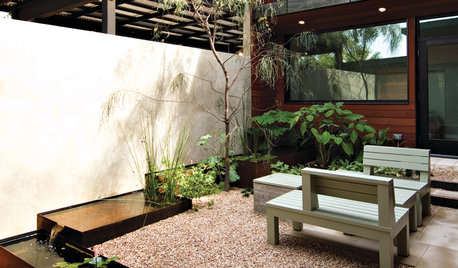How do you keep a balance between...
daniel_nyc
9 years ago
Related Stories

BOLD COLORHit a Bold Color Balance
A slap-happy approach to vivid hues equals a surefire dizzy spell. Keep your rooms in a happy state of equilibrium instead with these tips
Full Story
REMODELING GUIDESArchitect's Toolbox: Strike a Balance With Symmetry
Home exteriors, landscapes and interior rooms feel orderly and restful when designed with two mirror-image halves
Full Story
LANDSCAPE DESIGNStrike a Balance: Stuff vs. Space in the Garden
Zoom out to the big design picture before focusing on the little details, to create a garden with all the elements in balance
Full Story
SMALL HOMESHouzz Tour: Artistic Balance for a Brooklyn Studio
Opposite textures and finishes combine to give a 400-square-foot apartment depth and character
Full Story
ARCHITECTUREDutch Architects Balance the Familiar and the Avant-Garde
Peek inside a 2013 book to see bold new designs for modern living that never forget those living there
Full Story
ROOM OF THE DAYRoom of the Day: Elegance and Comfort Strike a Balance
A high-traffic Philadelphia family room combines rustic and refined elements with stylish durability
Full Story
KITCHEN OF THE WEEKKitchen of the Week: Seeking Balance in Virginia
Poor flow and layout issues plagued this kitchen for a family, until an award-winning design came to the rescue
Full Story
DECORATING GUIDESHow to Bring Balance to an Eclectic Look
Can you pull off design harmony with pieces of different eras and styles? You can with these tips
Full Story








donna_in_sask
carolyn137
Related Professionals
Kapaa Landscape Architects & Landscape Designers · Bridgeview Landscape Contractors · El Reno Landscape Contractors · Sun City Center Landscape Contractors · West Allis Landscape Contractors · Centereach General Contractors · Kentwood General Contractors · Leon Valley General Contractors · Newington General Contractors · Spencer General Contractors · Texas City General Contractors · Rancho Palos Verdes Decks, Patios & Outdoor Enclosures · Salem Decks, Patios & Outdoor Enclosures · San Jose Decks, Patios & Outdoor Enclosures · West Palm Beach Decks, Patios & Outdoor Enclosuresseysonn
digdirt2
PupillaCharites
sheltieche
daniel_nycOriginal Author
2ajsmama
digdirt2
2ajsmama
PupillaCharites
daniel_nycOriginal Author
2ajsmama
daniel_nycOriginal Author
2ajsmama